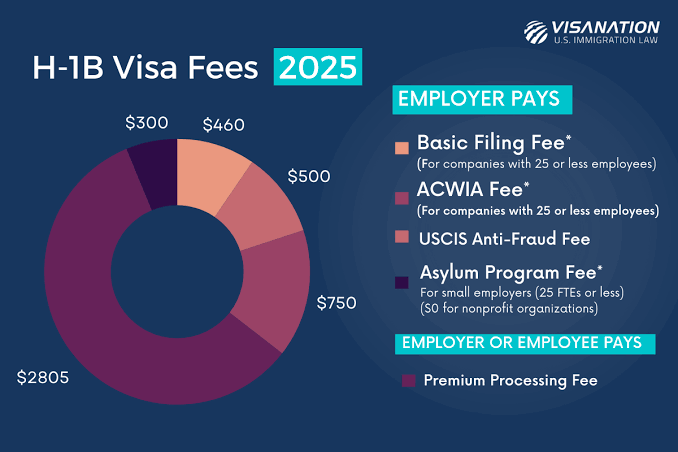 News
News
With rising H-1B costs, tighter regulations, and unpredictable processing times, U.S. employers are rethinking how they access global talent. Nearshore outsourcing has become the smarter, faster, and more cost-effective H1B alternative, offering skilled teams in nearby regions like Latin America who work in similar time zones and cultural settings. It eliminates visa complications, speeds up project delivery, and provides long-term workforce stability, making it the preferred choice for companies seeking flexibility and reliable growth.
Current Issues H-1B Visa Employers Are Facing in the U.S. And Why People Are Searching For H1B Alternatives
$100,000 Shock: Immediate Cost and Budget Scramble.
The single biggest shock employers are dealing with right now is the new presidential proclamation that imposes a $100,000 filing and entry cost on many new H-1B petitions. For firms used to paying several thousand dollars per hire, this is not a marginal change, it forces immediate rethinking of budgets, headcount forecasts, and whether a role can be filled domestically instead. Small businesses and early-stage startups, which typically operate with tight monthly burn, describe the fee as an outright hiring blocker. Larger firms are retooling their workforce plans to concentrate the limited hires on only the most strategic, revenue-critical roles.
Lottery Rework and Wage-Based Prioritization.
Policymakers are moving the H-1B allocation away from a pure random lottery toward systems that favor higher wage levels or weighted selection for higher-skilled and higher-paid roles. That means recruiting teams cannot assume the same odds they had in past years. Occupations that previously qualified comfortably for H-1B may now lose out unless the employer can justify a higher prevailing wage or show the role is truly specialized. Recruiters report needing stronger job descriptions, clearer wage justification, and more legal coordination before they submit registrations.
Prevailing Wage Tightening and Extra Documentation.
The Department of Labor and DHS guidance updates are tightening how prevailing wages are chosen and documented. Employers must be far more careful in selecting the correct wage level, mapping job duties to O*NET codes, and retaining proof that the wage offered matches the registration, because post-selection audits will scrutinize mismatches. Practically, that raises direct payroll costs for many positions and increases legal and compliance hours. HR, compensation teams, and immigration counsel are spending more time up front to avoid expensive audits or denials later.
Processing Backlogs and Lost Predictability.
USCIS and the broader immigration system are operating with larger backlogs and slower processing times in 2025, so even companies that clear the registration and filing hurdles face uncertain start dates. What used to be a predictable six-month or faster path can now take many months longer, and premium processing rules have been in flux. The result is that product teams and engineering managers can’t reliably plan release cycles around new hires, and employers are more frequently using short-term contract solutions or nearshore talent to cover gaps.
Enforcement, Audits, and Reputational Risk.
With stronger enforcement priorities, any perceived misuse of H-1B, such as improper wage classification, off-site staffing that looks like labor contracting, or inaccurate job descriptions, can trigger audits and steep penalties. Employers say the cost isn’t only financial. Audit notices tie up senior management time, slow hiring, and in some cases create negative press or employee anxiety. Many firms are therefore centralizing immigration decisions, leaning on outside counsel more heavily, and reducing ad-hoc local hiring that used to be handled informally by teams.
Talent Pipeline Friction.
Beyond employers, international students and recent graduates are reacting. Surveys and institutional reports indicate a rising reluctance among prospective graduate students to choose U.S. study if post-graduation work visas become harder or lower odds. That’s a longer-term risk for firms that hire from U.S. universities. Fewer applicants mean a smaller pool of early-career technical talent. Employers are therefore accelerating campus relationships and considering more global hiring channels, but those approaches take time to mature.
Strategic Responses Employers Are Using
→ Re-prioritizing Specialized Roles:
Employers are now focusing their limited H-1B sponsorships on positions that genuinely demand advanced expertise or specialized technical knowledge. Instead of applying for every open role, companies are concentrating on high-impact positions that directly influence innovation, core product development, or business growth. This selective approach ensures that every visa slot used brings long-term value and aligns with strategic goals rather than short-term staffing fixes.
→ Increasing Onshore Recruiting and Upskilling Initiatives:
Many firms are turning inward by developing local talent pipelines through apprenticeship programs, university partnerships, and in-house training. By identifying domestic candidates early and investing in skill development, businesses reduce dependency on foreign visa processes. Upskilling initiatives also enhance employee retention and build a workforce capable of handling evolving technological demands.
→ Leveraging contract, nearshore, and remote teams:
To maintain project continuity amid visa restrictions, companies are collaborating with contract professionals and nearshore teams across regions like Latin America and Canada. These partnerships provide access to skilled talent in similar time zones, ensuring smooth communication and efficient delivery. Remote hiring has also become a flexible solution, allowing businesses to fill roles quickly without facing immigration delays or regulatory risks.
→ Centralizing documentation and compliance oversight:
Organizations are strengthening their legal and administrative frameworks by centralizing all immigration-related processes. This includes prevailing wage determinations, role classifications, and attorney reviews. A unified system not only ensures consistency but also reduces the risk of errors or non-compliance during audits, protecting the company from unnecessary legal and financial penalties.
→ Conserving capital and delaying nonessential hires:
In the current uncertain regulatory climate, financial prudence is key. Many employers are choosing to delay noncritical hires until visa rules stabilize. By conserving capital and reassessing staffing priorities, they maintain operational flexibility and ensure funds are directed toward the most essential, growth-driving positions.
Why Nearshoring Is a Better Alternative to H-1B Hiring
With rising H-1B costs, tighter regulations, and unpredictable processing times, U.S. employers are rethinking how they access global talent. Nearshore outsourcing has become the smarter, faster, and more cost-effective alternative, offering skilled teams in nearby regions like Latin America who work in similar time zones and cultural settings. It eliminates visa complications, speeds up project delivery, and provides long-term workforce stability, making it the preferred choice for companies seeking flexibility and reliable growth.
1. Cost Efficiency Without Legal Complexities:
One of the biggest advantages of nearshoring is that it eliminates the heavy costs tied to H-1B sponsorships and compliance. Employers no longer have to deal with the $100,000 filing fees, attorney costs, or unpredictable visa lotteries. Nearshore hiring also saves on relocation expenses, long onboarding timelines, and potential legal exposure.
→ Partnering with skilled developers in Latin America or nearby regions offers top-tier technical expertise at more affordable market rates.
→ Companies maintain budget predictability by avoiding visa renewals, compliance filings, and government delays.
→ Nearshoring also allows firms to scale up or down quickly without being bound by visa-related employment contracts.
2. Time Zone Alignment and Real-Time Collaboration:
Unlike offshore teams in distant regions, nearshore developers work within or close to U.S. time zones. This overlap creates smoother communication and agile collaboration, which is key for modern nearshore software development.
→ Daily stand-ups, sprint planning, and code reviews can happen in real time with minimal scheduling issues.
→ Teams share similar business hours, reducing lag between feedback loops and accelerating product delivery.
→ Project managers and developers can engage directly without needing overnight updates or asynchronous communication tools.
3. Cultural and Linguistic Compatibility:
Cultural alignment plays a major role in team efficiency, and nearshore regions like Latin America offer strong compatibility with U.S. business culture. Professionals in these countries are often fluent in English and well-versed in Western work ethics.
→ Shared communication norms and collaboration styles make teamwork more natural and efficient.
→ Developers adapt quickly to company culture and workflows, reducing onboarding friction.
→ Customer-facing projects benefit from clear language understanding and cultural sensitivity.
4. Access to High-Caliber Talent Pools:
Nearshoring opens access to a large, growing pool of experienced developers across countries like Mexico, Colombia, Argentina, and Brazil, many of whom specialize in modern technologies like React, Node.js, Python, and cloud engineering.
→ These professionals often hold international certifications or have worked with U.S. clients before, ensuring high technical standards.
→ Governments in Latin America are heavily investing in STEM education, further strengthening the regional talent base.
→ Employers can tap into niche skill sets quickly without waiting for long recruitment cycles or H-1B processing.
5. Faster Onboarding and Project Kickoff:
Nearshore collaboration significantly shortens the time between candidate selection and project initiation. Without visa approvals or relocation steps, new hires can start within days or weeks.
→ Companies can respond faster to product launches, seasonal demands, or urgent client projects.
→ Streamlined onboarding processes minimize downtime and maintain delivery momentum.
→ Rapid scalability ensures teams can be expanded immediately when business priorities shift.
6. Regulatory Stability and Reduced Risk:
H-1B visa rules are prone to sudden policy changes, audits, and compliance risks. Nearshoring, on the other hand, offers stable hiring conditions under local employment laws and clear contractual agreements.
→ Businesses avoid exposure to unpredictable immigration reforms or enforcement crackdowns.
→ Legal compliance is easier since nearshore employment follows local regulations rather than federal immigration frameworks.
→ Centralized agreements with nearshore partners ensure transparent billing, data protection, and labor law adherence.
7. Stronger Data Security and Intellectual Property Protection:
Modern nearshore firms maintain high standards of cybersecurity, often complying with GDPR, ISO, or SOC 2 certifications. Working within similar legal frameworks ensures intellectual property is safeguarded.
→ Many nearshore providers sign strict NDAs and follow the same compliance measures used by U.S. firms.
→ Time zone proximity allows more direct oversight and real-time monitoring of development processes.
→ This proximity also strengthens trust, which is critical for projects involving proprietary software or sensitive business data.
8. Sustainable Long-Term Workforce Strategy:
Nearshoring is not just a short-term fix to visa challenges; it is a long-term talent strategy that supports growth and stability.
→ Companies can build dedicated development centers or long-term partnerships with regional teams, fostering loyalty and institutional knowledge.
→ Nearshore employees enjoy stable employment without relocation pressure, leading to better retention rates.
→ Over time, organizations develop hybrid team structures that balance in-house and nearshore talent efficiently.
Avoiding H1B and Building Scalable Teams Through Nearshore Excellence
Blue Coding is fully aware of the growing complexity of global hiring and the increasing costs of H-1B sponsorship. That’s why we offer a seamless nearshore development model that gives U.S. companies direct access to top-tier Latin American talent. Our developers work in matching time zones, communicate clearly, and deliver high-quality code that drives business results. Contact us today to learn how our cutting-edge software solutions can help you build a stronger, more agile development team.




